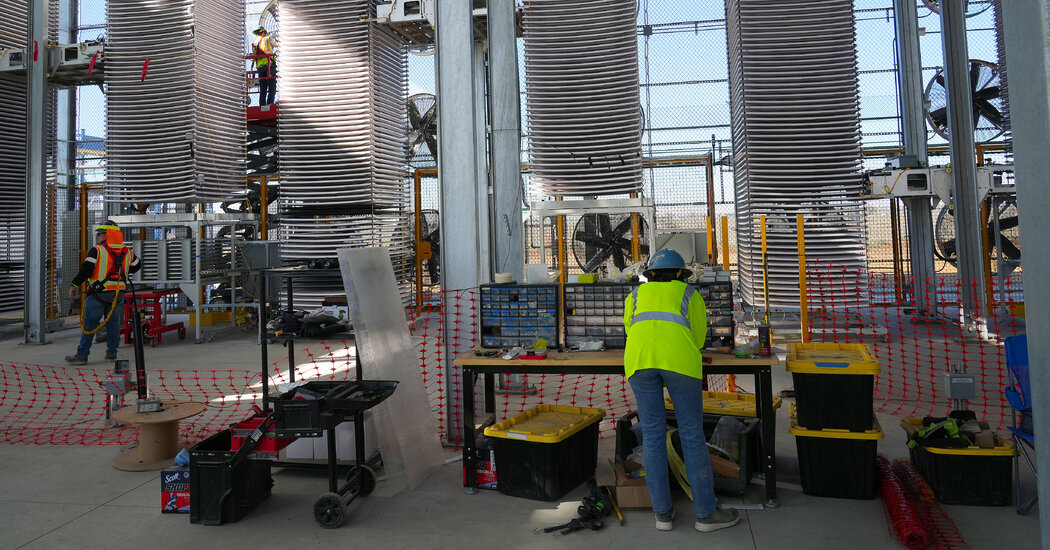To earn revenue, the company is selling carbon removal credits to companies paying a premium to offset their own emissions. Microsoft has already signed a deal with Heirloom to remove 315,000 tons of carbon dioxide from the atmosphere.
And this is why direct air capture is a farce right now - any progress they make is literally counter acted by large corporations who will increase their carbon output because they have a contract with a company like this.
Carbon air capture technology paired with 100% clean energy can save the world from a lot of hardship in the near future, but not like this.
I think it’s the opposite. This paves the way to enforce companies to pay to remove the carbon they emit. If this can be profitable then there is room to invest on improvements making it more feasible at large scale.
bro im starting one of these companies
Do you think Microsoft was holding back expanding its business because if carbon output?
They took all the trees and put them in a tree museum.
They paved paradise and put up a parking lot.
Ok Joni
Wouldn’t it be more efficient to use algae for that and stuff the slime directly in the borehole?
Possible not, you need to maintain the growth conditions for the algae, that has some meaningful energy cost.
Glass panel over it for greenhouse?
Can’t use more power than carbon skimming.
I actually helped research this as an undergrad. The problem we’d always face is there are certain microorganisms, like rotifers, that can just decimate a tank of algae. Many rotifer species are parthenogenic, so it literally only takes one rotifer to knock out an entire algae tank.
What if we genetically modified the algae to be impossible to kill and survive in extreme conditions. Like the algae equivalent of kudzu.
Now coming to everyone soon: algae world! All algae all the time! Covered in slime? That’s worth a dime! There is no escaping it, not even a bit.
It’ll be fine.
If it gets out of hand we’ll just engineer an equally hardy and aggressive rotifer to kill all the algae.
You’re basically exchanging a world-ending Gray Goo Scenario for a world-ending Green Goo Scenario.
You need more than a green house lol.
I only ever had problems with too much algae in our pond…
You’ve figured it out.
This is the best summary I could come up with:
In an open-air warehouse in California’s Central Valley, 40-foot-tall racks hold hundreds of trays filled with a white powder that turns crusty as it absorbs carbon dioxide from the sky.
The start-up that built the facility, Heirloom Carbon Technologies, calls it the first commercial plant in the United States to use direct air capture, which involves vacuuming greenhouse gases from the atmosphere.
Critics point out that many artificial methods of removing carbon dioxide from the air are wildly expensive, in the range of $600 per ton or higher, and some fear they could distract from efforts to reduce emissions.
In an attempt to build confidence in the market, the Energy Department in September announced it would buy $35 million worth of carbon removal credits from up to 10 providers, in order to establish new guidelines around what counts as a “high quality” project.
“There’s a big difference between exploring an infant technology to see if it can be developed, versus telling the public, ‘If we do this, we can continue burning fossil fuels forever,’” former Vice President Al Gore said at a recent New York Times event.
The debate over how big a role carbon removal should play in tackling climate change is still in early stages, said Emily Grubert, associate professor of sustainable energy policy at the University of Notre Dame.
The original article contains 1,647 words, the summary contains 222 words. Saved 87%. I’m a bot and I’m open source!
Unfortunately I can’t read the article. What do they do with the carbon once it’s collected? How are these powered? How much power does the collector use compared to how much it collects? If stored, where and how?
At the California plant, workers heat limestone to 1,650 degrees Fahrenheit in a kiln powered by renewable electricity. Carbon dioxide is released from the limestone and pumped into a storage tank.
The leftover calcium oxide, which looks like flour, is then doused with water and spread onto large trays, which are carried by robots onto tower-high racks and exposed to open air. Over three days, the white powder absorbs carbon dioxide and turns into limestone again. Then it’s back to the kiln and the cycle repeats.
“That’s the beauty of this, it’s just rocks on trays,” Mr. Samala, who co-founded Heirloom in 2020, said. The hard part, he added, was years of tweaking variables like particle size, tray spacing and moisture to speed up absorption.
The carbon dioxide still needs to be dealt with. In California, Heirloom works with CarbonCure, a company that mixes the gas into concrete, where it mineralizes and can no longer escape into the air. In future projects, Heirloom also plans to pump carbon dioxide into underground storage wells, burying it.
So they’re using the “limestone -> quicklime -> slaked lime -> limestone” cycle. The kiln must be powered by renewables (otherwise the process is pointless), but it’s a perfectly reasonable capture method.
Storage is slightly less straightforward. Concrete naturally absorbs carbon dioxide over decades, mixing carbon dioxide in during production is just accelerating the inevitable.
Additionally, the reason concrete can absorb carbon dioxide is that cement contains quicklime, which is mainly produced by… you guessed it, heating limestone to release the carbon dioxide! The concrete won’t absorb more carbon dioxide than was released during its production, so making excess concrete is not a solution to CO2 capture. However, if the concrete was going to be produced anyway (and we produce a lot), I suppose it’s slightly better to have it absorb carbon dioxide sooner rather than later.
Pumping carbon dioxide into underground storage wells a more scalable solution, provided that the local geology (olivine?) can absorb the carbon dioxide.
An alternative not discussed in the article is to reduce the carbon dioxide into various feedstock chemicals that we currently derive from fossil fuels. Again, this would need to be powered by renewables otherwise the process is pointless.
You a wonderful. Thank you for this.
You’re welcome!
absolute bullshit, it burns more in carbon to run those machines than it takes out, this is making shit worse at an accelerated pace
You might want to read the article more carefully.
At the California plant, workers heat limestone to 1,650 degrees Fahrenheit in a kiln powered by renewable electricity.
Direct-air carbon capture has its fair share of problems to overcome before it can become a practical solution, but any such process must obviously be powered by renewables. To do otherwise would be pointless.









